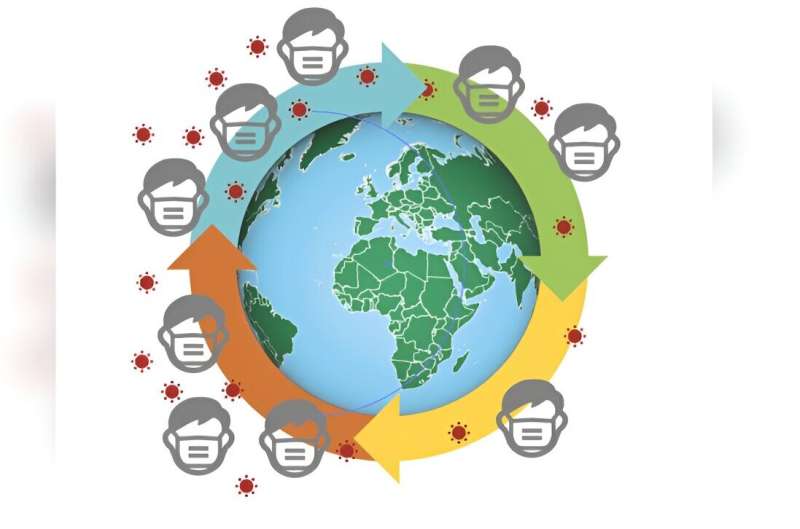This article has been reviewed according to Science X's editorial process and policies. Editors have highlighted the following attributes while ensuring the content's credibility:
fact-checked
trusted source
proofread
COVID-19 likely to peak in colder months as virus becomes endemic, finds study

As COVID-19 becomes endemic in the United States, infecting populations in wave after wave annually, scientists are trying to determine whether the timing of these surges will ever be predictable.
According to a new study by researchers at the Yale School of Public Health (YSPH) and the University of North Carolina at Charlotte, the virus will likely settle into a seasonable rhythm like influenza, becoming most active during the colder months in northern climes and subsiding in summer. The study was published in mBio.
"Having some idea of when we'll have surges in the future is important for public health policy and decision-making," said first author Jeffrey Townsend, the Elihu Professor of Biostatistics and Professor of Ecology and Evolutionary Biology. "Late fall, winter, and early spring are the highest-risk times for surges of infection."
Such information can help clinics and hospitals prepare for large numbers of COVID-19 patients. This foreknowledge is especially important because other respiratory viruses like influenza and respiratory syncytial virus (RSV) may be active around the same time, further burdening health care systems.
Learning from the relatives
The researchers predicted future seasonality—when during the year SARS-CoV-2 (the virus causing the illness known as COVID-19) will most actively circulate—using historic infection data from coronaviruses with known seasonal patterns that are often attributed to causing colds.
"Information from close relatives is really powerful for predicting traits," said Townsend. "If I told you I've found a new organism that is closely related to a finch, you would assume that it flies, that it stands on two legs on branches, and so on. You're inferring all these traits based on the fact that it's closely related to something that you already know."
Seasonality can be considered a viral trait based on genetics, Townsend explained. How the connection between genetics and seasonality occurs is a black box involving complex interactions with people and society. But understanding this mechanism, if that were even possible, isn't necessary for purposes of prediction, he said.
"SARS-CoV-2 diverged from the other human coronaviruses thousands of years ago—recent by evolutionary standards," said Alex Dornburg, assistant professor of bioinformatics and genomics at the University of North Carolina at Charlotte and co-author of the study.
"And while the genetic code for the spike protein that interacts with our immune systems evolves fast, leading to repeat infections and requiring constant vaccine updates, the code for the virus' other basic functions doesn't change at the same pace."
Knowing when SARS-CoV-2's relatives peak in seasonality, plus how closely SARS-CoV-2 is related to each, allowed the research team to make inferences.
The team analyzed monthly infection data of common-cold coronaviruses reported in previous studies conducted in locations in Europe, East Asia, and North America. Collectively, these studies had amassed viral samples from thousands of people between 1985 and 2020.
Using statistical methods, the researchers estimated that SARS-CoV-2 will tend to surge in colder months, at least in the temperate places of the Northern Hemisphere they studied. However, the exact timing will vary by location.
In Rochester, Minnesota, for example, incidence will often rise sharply in December and remain elevated through late spring, while in Edinburgh, U.K. the surge will usually begin more gradually in autumn and largely subside by mid-spring.
A key caveat: the results apply once COVID-19 becomes an endemic disease. That hasn't happened yet, but most experts agree it's coming, Townsend said.
Previous studies attempted to predict SARS-CoV-2's seasonality by looking at factors such as temperature and humidity. However, during a pandemic, public health interventions like masking and social distancing alone can affect infection rates and skew data gathered at specific times of the year.
What will endemicity look like? "It's steady in the population—our immune systems have been exposed to it a bunch of times, we're trucking along without interventions, and it's spreading the same way every year," Townsend said. "How many years it will be until we reach that point is unclear. Maybe we're almost there, or maybe it'll be another 10 years."
More information: Jeffrey P. Townsend et al, Seasonality of endemic COVID-19, mBio (2023). DOI: 10.1128/mbio.01426-23




















